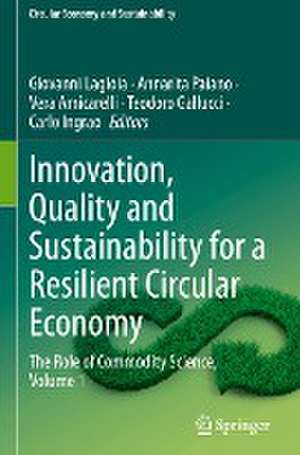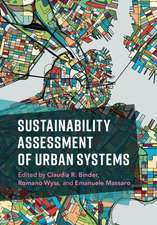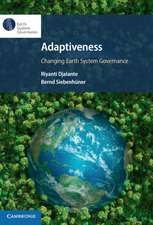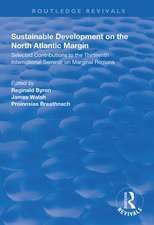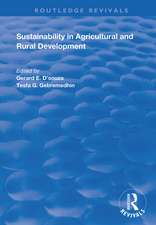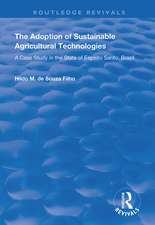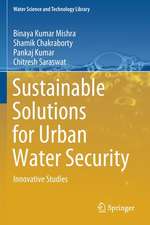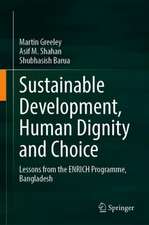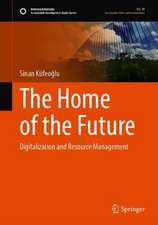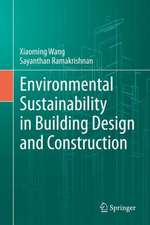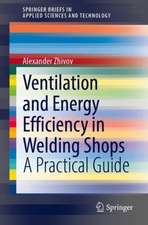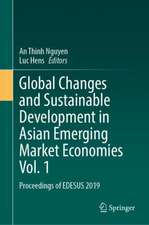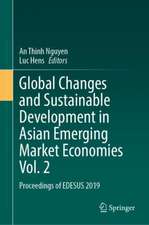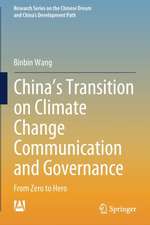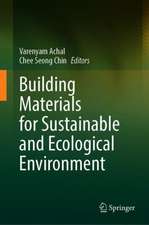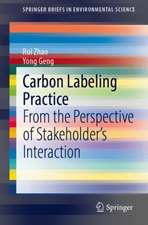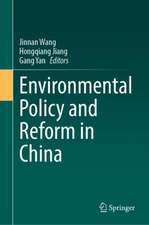Innovation, Quality and Sustainability for a Resilient Circular Economy: The Role of Commodity Science, Volume 1: Circular Economy and Sustainability
Editat de Giovanni Lagioia, Annarita Paiano, Vera Amicarelli, Teodoro Gallucci, Carlo Ingraoen Limba Engleză Hardback – 24 feb 2024
Under this perspective, the book highlights the central role that Commodity Science can play, also considering the multiple possibilities of interacting with other relevant research sectors, like food production and packaging, engineering, environmental science, organisation, management, decision science, and social science, so enabling valorisation and rmaximisation. These interactions will appeal to academics, producers, decision- and policymakers, and other stakeholders.Thus, this book has a multidisciplinary holistically integrated approach to Commodity Science that contributes to enhancing the current literature and knowledge.
| Toate formatele și edițiile | Preț | Express |
|---|---|---|
| Hardback (2) | 1231.47 lei 3-5 săpt. | |
| Springer Nature Switzerland – 27 apr 2024 | 1231.47 lei 3-5 săpt. | |
| Springer International Publishing – 24 feb 2024 | 1477.55 lei 38-44 zile |
Preț: 1477.55 lei
Preț vechi: 1944.14 lei
-24% Nou
Puncte Express: 2216
Preț estimativ în valută:
282.77€ • 294.12$ • 233.44£
282.77€ • 294.12$ • 233.44£
Carte tipărită la comandă
Livrare economică 11-17 aprilie
Preluare comenzi: 021 569.72.76
Specificații
ISBN-13: 9783031282911
ISBN-10: 3031282914
Pagini: 541
Ilustrații: XXX, 541 p. 1 illus.
Dimensiuni: 155 x 235 mm
Ediția:2024
Editura: Springer International Publishing
Colecția Springer
Seria Circular Economy and Sustainability
Locul publicării:Cham, Switzerland
ISBN-10: 3031282914
Pagini: 541
Ilustrații: XXX, 541 p. 1 illus.
Dimensiuni: 155 x 235 mm
Ediția:2024
Editura: Springer International Publishing
Colecția Springer
Seria Circular Economy and Sustainability
Locul publicării:Cham, Switzerland
Cuprins
Part I. Agriculture, Biomass, Foods and Beverages.- 1. Key factors of Digital agriculture on competitiveness, sustainability, and safety areas.- 2. Precision Agriculture technologies in the Italian agricultural context. A study on the rate of knowledge and diffusion among Italian farmers.- 3. The Role of Technological Innovations for Agrifood Resilience: A Systematic Literature Review.- 4. The agri-food products life cycle: the technological dimension role in an open innovation perspective.- 5. Innovation in the food sector: development prospects for synthetic meat production.- 6. Valorization strategies of technological and therapeutic properties of orange by-products.- 7. Circular economy in the agri-food industry. How social media create engagement.- 8. Circular urban food policies: the "Food in the circular city" model promoted by the city of Prato.- 9. S-LCA applied in a research project and social conditionality of the new Common Agriculture Policy 2023-2027.- 10. The S-LCA applied in a research project: “smallholders including farmers” impact subcategory.- 11. The potential of soil carbon sequestration: International and national soil carbon projects.- 12. Eco-innovation and digitalization of agri-food companies towards the circular economy: A pilot project for the evaluation of the impacts and circularity indicators for the agri-food chain.- 13. Application of the DNSH principle to the restoration and enhancement of a historical garden: the project "Well-being and spirituality: Orto-giardino Laudato Sì".- 14. The adoption of information systems for the analysis of the life cycle of hazelnuts.- 15. Sweet chestnut fractions from sustainable circular process for the control of phytopathogenic oomycetes.- 16. A circular bioeconomy chain: indicators applied to the sustainable production of microalgae for industrial purposes.- 17. The ILCIDAF project for the development of an Italian Database of Life Cycle Inventory of agri-food products: the wheat milling phase.-18. Life Cycle Inventory data for the Italian olive oil supply chain: how to ensure representativeness.- 19. Carbon Footprint of seasonal meals: the case of school canteens.- 20. Water Footprint of agri-food products from MENA countries vs. EU.- 21. The air indicator of VIVA certification for the sustainability of Italian wine: analysis and perspectives.- 22. Environmental accounting for the circularization of the packaged water sector in Italy.- 23. Recent evolutions in food consumption patterns during the Covid-19 emergency. The emerging market of Food Delivery and its implications on food quality.- 24. Foods Supplements: quality assessment of formulations by expert panel.- 25. Wine quality improvement based on the perception of Protected Designation of Origin (PDO) and Protected Geographical Indication (PGI) - evidence from Bulgaria.- 26. Multi-elemental characterisation and multivariate analysis of Venetian Protected Designation of Origin (PDO) wines.- 27. Study of the volatile component and the flavonoid content of edible flowers.- 28. The cultivation of Iris pallida as an opportunity for the enhancement of Tuscan agro-biodiversity and a resource for the local economy.- 29. Honey Production in Italy: Quality, Sustainability, and Innovation Strategies of Companies in the Abruzzo Region.- 30. Determination of bioactive compounds in Italian honeydew honeys.- 31. Comparison of the carotenoid content in durum wheat pasta and wholewheat pasta by multivariate analysis.- 32. The likely effect of the rise in global temperature on cheese safety.- 33. Tomato supply chain and production quality control for international markets.- 34. Sustainability of rural supply chains in Nepal: selection, characterization and labelling of spices for the local market.- 35. Carob leaves extracts as new ingredients in the food field: extraction, characterization and antioxidant features.- 36. Carob Pods as Source of Bioactive Molecules in the Preparation of Functional Jelly.- 37. Crocus sativus L. flowers valorisation as sources of bioactive compounds.- Part II. Consumers’ awareness, and behaviors.- 38. An empirical study to understand if sustainable consumers have sustainable behaviours.- 39. Greenwashing and consumer awareness on environmental issues: a pilot analysis.- 40. What factors influence post-Covid-19 consumer purchase habits? An empirical survey in the Italian agri-food sector.- 41. Towards a sustainable diet: the profile of vegan and vegetarian Italian consumers.- 42. Not in My Backyard or Please in My Backyard? A PRISMA-based literature review.- 43. From knowledge to consumption: how consumers perceive of the food quality.- 44. Exploring consumer and company perceptions of the use of digital technologies for traceability.- 45. Functional properties and preferences of consumption of honeys from different origin.- 46. Food safety and insect food: a preliminary consumers’ indication.- Part III. Digitalization.- 47. Digital Innovation Ecosystems: a Systematic Literature Review and a New Definition.- 48. Smart City and Internet of Things.- 49. Digital transformation in companies and human resource management.- 50. “Everything-as-a-service”: l’evoluzione del mercato privato dei beni in piattaforma pubblica di servizi.- 51. Supply chain 4.0: lean six sigma, industry 4.0 technologies and circular supply chain applied to an italian hospital case study.- 52. Bibliometric Analysis and Topic Modeling of the literature on Artificial Intelligence in Healthcare.- 53. Digital innovation in the healthcare system: integration between blockchain and artificial intelligence.- 54. The role of multi-stakeholder platforms in the path towards Circular Economy (CE) transition in Europe.- 55. Green Smart Manufacturing: potentials and limits towards Industry 5.0.- 56. The use of unmanned aerial systems in environmental monitoring.- Part IV. Circular economy and sustainability issues in several sectors.- 57. Natural gas supply in Italy: analysis and perspectives.- 58. The agro-photovoltaic sector as a possible implementation tool in Sicilian energy transition.- 59. Redevelopment of industrial brownfields through green hydrogen: evolution and criticalities.- 60. Life Cycle Assessment and Life Cycle Costing of a unitized regenerative fuel cell stack: a preliminary study.- 61. A Hypothesis of a Lean Warehouse Design for an Italian Textile-Apparel Company.- 62. Textile industry between past and future in the ‘Museo Merceologico’ (MuMe).- 63. Production and consumption trends in the European textile sector and main sustainability challenges.- 64. The future of the Italian tanning industry considering the recent geopolitical crisis.- 65. Risk assessment and life cycle approach to optimize the sustainability performance of leather products.
Notă biografică
Giovanni Lagioia (University of Bari Aldo Moro, Bari, Italy) is a full professor at the University of Bari Aldo Moro. He has a PhD in Commodity Science. He is also the Head of the Department of Economics, Management and Business Law at the University of Bari Aldo Moro. He teaches Commodity Science, Environmental Strategies for Circular Economy, and Waste Management. His main research topics include Bioenergy, the End-of-Life Management, MFA, LCT, Input-Output Analysis, and Circular Economy.
Annarita Paiano (University of Bari Aldo Moro, Bari, Italy) holds a master’s degree in Economics and has a PhD. She is currently an associate professor of Commodity Science, Technology, Innovation and Sustainable Production at the University of Bari Aldo Moro. She is also an Editorial Board Member and reviewer of international journals such as MPDI, Elsevier, Springer and others. She uses LCA, MFA, Carbon Footprint, and Water Footprint-based Approaches.
Vera Amicarelli (University of Bari Aldo Moro, Bari, Italy) is an associate professor at University of Bari Aldo Moro. She has a PhD in Commodity Science. She teaches Industrial Ecology, Quality, Environment and Sustainability and Resource and Waste Management. Her main research interests focus on Material Flow Analysis, Natural Resources and Environmental Management and Circular Economy. Since 1996, she has been a member of the Italian Commodity Science Academy (AISME).
Teodoro Gallucci (University of Bari Aldo Moro, Bari, Italy) is an associate professor at University of Bari Aldo Moro. He has a PhD in Commodity Science. His main research topics concern the study and analysis of production processes through the methodology of life cycle thinking, such as Life Cycle Assessment (LCA) applied to different economic sectors.
Carlo Ingrao (University of Bari Aldo Moro, Bari, Italy) is a tenure-track assistant professor in “Commodity Science” at the University of Bari Aldo Moro. He has an MSc degree in “Engineering for the Environment and the Territory” from the University of Catania and a PhD in “Civil Infrastructure for the Territory” from Kore University of Enna, Italy and in “Geotechnical Engineering” from University of Catania, Italy. His research interests include Development of Life-Cycle Energy and Environmental Assessments in the field of Commodity Sciences and in related others.
Annarita Paiano (University of Bari Aldo Moro, Bari, Italy) holds a master’s degree in Economics and has a PhD. She is currently an associate professor of Commodity Science, Technology, Innovation and Sustainable Production at the University of Bari Aldo Moro. She is also an Editorial Board Member and reviewer of international journals such as MPDI, Elsevier, Springer and others. She uses LCA, MFA, Carbon Footprint, and Water Footprint-based Approaches.
Vera Amicarelli (University of Bari Aldo Moro, Bari, Italy) is an associate professor at University of Bari Aldo Moro. She has a PhD in Commodity Science. She teaches Industrial Ecology, Quality, Environment and Sustainability and Resource and Waste Management. Her main research interests focus on Material Flow Analysis, Natural Resources and Environmental Management and Circular Economy. Since 1996, she has been a member of the Italian Commodity Science Academy (AISME).
Teodoro Gallucci (University of Bari Aldo Moro, Bari, Italy) is an associate professor at University of Bari Aldo Moro. He has a PhD in Commodity Science. His main research topics concern the study and analysis of production processes through the methodology of life cycle thinking, such as Life Cycle Assessment (LCA) applied to different economic sectors.
Carlo Ingrao (University of Bari Aldo Moro, Bari, Italy) is a tenure-track assistant professor in “Commodity Science” at the University of Bari Aldo Moro. He has an MSc degree in “Engineering for the Environment and the Territory” from the University of Catania and a PhD in “Civil Infrastructure for the Territory” from Kore University of Enna, Italy and in “Geotechnical Engineering” from University of Catania, Italy. His research interests include Development of Life-Cycle Energy and Environmental Assessments in the field of Commodity Sciences and in related others.
Textul de pe ultima copertă
This book is a selection of the best papers presented at the XXX National Conference of Commodity Science held in Bari, Italy on 27 to 28th October, 2022. It is designed to help advance the knowledge and application of Commodity Science in innovation, quality, and sustainability principles and goals. Furthermore, it provides support in confronting the current environmental and socioeconomic challenges and contributes to addressing and solving those concerns in a circular economy context.
Under this perspective, the book highlights the central role that Commodity Science can play, also considering the multiple possibilities of interacting with other relevant research sectors, like food production and packaging, engineering, environmental science, organisation, management, decision science, and social science, so enabling valorisation and rmaximisation. These interactions will appeal to academics, producers, decision- and policymakers, and other stakeholders.
Thus, this book has a multidisciplinary holistically integrated approach to Commodity Science that contributes to enhancing the current literature and knowledge.
Under this perspective, the book highlights the central role that Commodity Science can play, also considering the multiple possibilities of interacting with other relevant research sectors, like food production and packaging, engineering, environmental science, organisation, management, decision science, and social science, so enabling valorisation and rmaximisation. These interactions will appeal to academics, producers, decision- and policymakers, and other stakeholders.
Thus, this book has a multidisciplinary holistically integrated approach to Commodity Science that contributes to enhancing the current literature and knowledge.
Caracteristici
Provides quantitative tools for addressing environmental management Advances application in Circular Economy and Innovation Advances application in Waste Management
